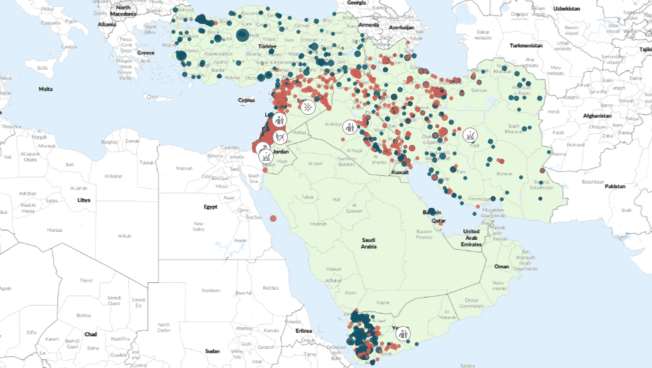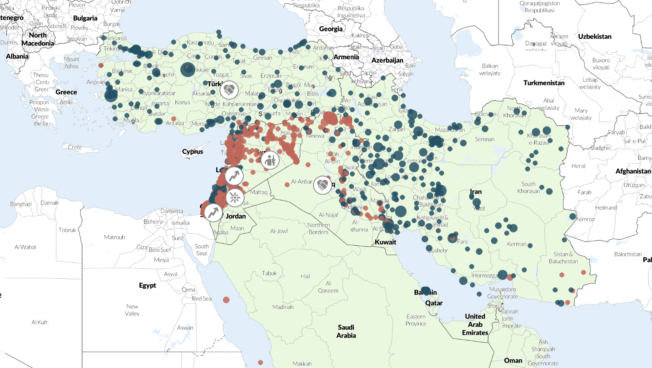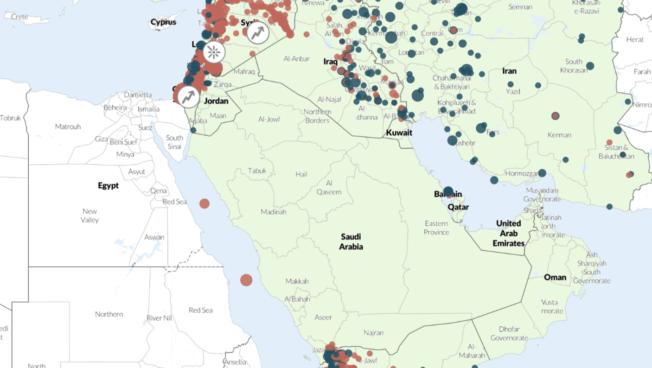September 2024 Special Issue
Expanding Israeli operations in Lebanon and the escalation of the Middle East crisis
Posted: 4 October 2024
The Middle East crisis has entered a new phase after two weeks of unprecedented Israeli attacks on Lebanon and the killing of Hezbollah’s leader on 27 September. During the past month, Israel also launched attacks on Hezbollah and Iranian logistics networks in Syria, while ramping up airstrikes on the Houthis in Yemen. Nearly a year after the war in Gaza began, attacks by several members of the Iran-linked ‘axis of resistance’ to pressure Israel have not led to the intended ceasefire, with Israel demonstrating a clear willingness to escalate further and engage on multiple fronts. Throughout the year-long hostilities, Hezbollah had confined its attacks geographically, mostly targeting Israeli military sites and refraining from using more advanced weapons. Likewise, its Iranian ally did not show any appetite to open a full front against Israel and avoided major escalatory moves even after the assassination of Hamas leader Haniyeh in Tehran. Nevertheless, Israel increasingly appeared poised to expand its military actions. With the start of Israel’s ground operations in southern Lebanon on 1 October, followed by Iran’s launch of ballistic missiles into Israel, the stakes have risen significantly, and the Middle East now stands at a precarious crossroads.
In this Regional Overview
- Gaza: Decline in violence as Israel shifts focus to the northern front
- Lebanon: Israel kills Hezbollah leader and significantly ramps up airstrikes
- Iraq: The Islamic Resistance in Iraq claims several attacks targeting Israel in support of Hezbollah Israel launches Rafah offensive in Gaza
- Syria: Israel conducts a raid in Hama province aimed at disrupting weapons supply channels
- Yemen: Houthi forces pause attacks on ships and target Israel again
Gaza: Decline in violence as Israel shifts focus to the northern front
Nearly a year after the start of the war between Israel and Hamas, violence in Gaza dropped to its lowest monthly level of the past 12 months as Israel shifted its focus to its northern front. September began with a lull in fighting after Israel and Hamas agreed to daily eight-hour pauses in fighting in different areas of Gaza to facilitate the United Nations’ polio vaccination campaign.1Times of Israel, ‘WHO “confident” over 90% of children in Gaza received first polio vaccine dose,’ 12 September 2024 The Israel Defense Forces (IDF) continued to conduct airstrikes throughout the month, with approximately 400 incidents recorded across the Strip. Though this marked an over 20% decrease compared to the preceding month, the airstrikes continued to inflict fatalities, not only on militants, but also on civilians. In nearly 40 instances, airstrikes hit locations that housed displaced Palestinians, which the IDF claims are also Hamas command centers. Notably, on 10 September, an airstrike on tents housing displaced people in the al-Mawasi humanitarian zone in Khan Yunis reportedly killed at least 19 people, including women and children. The IDF claimed that three key Hamas commanders were the target of the attack, but it did not confirm they were killed.2Emanuel Fabien, ‘IDF says it hit 3 Hamas commanders in Gaza tent camp, contests claim dozens killed,’ Times of Israel, 10 September 2024 In another incident, IDF warplanes struck two schools housing displaced people in Gaza City on 21 September, reportedly killing 30, including 13 children and six women.
While armed clashes continued on a downward trend, fighting on the ground did not fully cease during September, with a small number of clashes reported in Gaza City’s al-Zaytun neighborhood, Bayt Lahiya in North Gaza, and al-Fukhari in Khan Yunis. Though at a reduced rate compared to the preceding month, Hamas and its allies continued to target Israeli forces with explosives, including in Rafah governorate, even after the IDF announced it had dismantled Hamas’ Rafah brigade on 12 September. Four IDF soldiers were killed on 17 September in Tal al-Sultan in Rafah after they entered a booby-trapped building. With Israel now focusing its fighting on Hezbollah and potentially Iran, the war in Gaza is expected to continue as a low-intensity war of attrition.
Lebanon: Israel kills Hezbollah leader and significantly ramps up airstrikes
Israel significantly escalated its operations against Hezbollah in September, conducting over 1,700 strikes on Lebanon — a more than 125% increase from the previous month. ACLED’s Conflict Exposure Calculator estimates that 32% of the population was exposed to conflict in Lebanon in September, up from 13% in August. This most recent escalation, which followed the assassination of Hezbollah commander Fuad Shukr in July and increasing hostilities near the Israeli-Lebanese border, began with a series of unprecedented suspected Israeli operations in which Hezbollah’s pagers and walkie-talkies exploded on 17 and 18 September, resulting in a total of at least 39 reported fatalities and thousands of injuries.3National New Agency, ‘Al-Abyad: Seventy martyrs is the total toll of three days of successive Israeli attacks,’ 21 September 2024 Although the operation targeted Hezbollah operatives, the group’s deep integration into Lebanese society meant that many explosions affected civilian areas, with incidents reported across six Lebanese governorates.
Israel continued its escalation on 23 September, carrying out approximately 200 airstrike events across five governorates, three times as many incidents compared to the previous peak of Israeli strikes on 25 August. While Israel claimed that Hezbollah’s military infrastructure was targeted, the Lebanese Health Ministry reported that many civilians, including 50 children and 94 women, were among the 569 people killed on 23 September4United Nations, ‘”Hell Is Breaking Loose” in Lebanon, All-Out War Must Be Avoided, Secretary-General Tells Security Council,’ 25 September 2024 — the deadliest day for Lebanon in decades.
In a major development, on 27 September, Israel killed Hezbollah’s leader, Hassan Nasrallah, and other senior Hezbollah figures, including the group’s southern front commander. This dealt a severe blow to Hezbollah’s command structure, with at least seven high-ranking figures killed in the last week of September.5Kareem Chehayeb and Jack Jeffery, ‘Who were the 7 high-ranking Hezbollah officials killed over the past week?’ Associated Press, 30 September 2024 These killings are the latest in a year-long campaign targeting high-ranking Hezbollah figures. Between October 2023 and 22 September 2024, Israel also killed at least 21 other Hezbollah commanders in Lebanon (for more, see this ACLED Insight). The intense Israeli attacks on Hezbollah’s leadership, military infrastructure, arsenal, and communications network have significantly weakened the Lebanese armed group. Yet, it would be too soon to declare victory for Israel and count Hezbollah out, as it is a group with deep roots among the Shiite population and steady support from Tehran, which will, in all likelihood, continue to build its military capabilities.
Iraq: The Islamic Resistance in Iraq claims several attacks targeting Israel in support of Hezbollah
In September, several Iraqi militia leaders, including those from Kataib Sayyid al-Shuhada and Asaib Ahl al-Haq, vowed military support for Hezbollah following the intensification of Israeli attacks on Lebanon.6Dana Taib Menmy; ‘Iraqi armed militias declare readiness to send forces in support of Lebanon’s Hezbollah against Israel,’ The New Arab, 23 September 2024 The Islamic Resistance in Iraq — an umbrella group name used by various Shiite Iraqi militias when claiming operations against the US and Israel since the start of the war in Gaza — launched several attacks targeting Israel and Israeli interests during the last week of September. Although most projectiles were intercepted, a drone struck the port of Eilat on 25 September, lightly injuring two civilians. Shiite militias had previously targeted US positions and interests in nearly 70 incidents in Iraq since October 2023, in addition to over 180 additional occurrences in Syria. The attacks largely ceased after the US conducted a series of retaliatory airstrikes in February. It is still unclear if a more coordinated and forceful response by Shiite militias in Iraq, which could include renewed targeting of US interests, will materialize in the future, but it may be more likely if Iran and Israel become further entangled in an open conflict.
In response to escalating tensions, US forces in Iraq increased security measures at Ayn al-Asad Base.7Zaid Salem and Muhammad Ali, ‘Iraq: Alert at Ain al-Assad base in anticipation of attacks,’ The New Arab, 23 September 2024 The base began its most extensive training exercises in years, emphasizing air defense, and received multiple reinforcements.8Al Maalomah, ‘Giant American aircraft land at Ain al-Assad base,’ 16 September 2024; Al Maalomah, ‘US military reinforcements coming from Kuwait to Ain al-Assad base,’ 24 September 2024 US forces also blocked Iraqi aircraft GPS signals and conducted flights over Popular Mobilization Forces (PMF) sites, prompting the PMF to enhance security in western al-Anbar province.9Baghdad Today, ‘A source reveals that the Americans have blocked the GPS system in western Anbar,’ 10 September 2024; Al Maalomah, ‘Popular Mobilization Forces take strict measures on their sites,’ 25 September 2024 Amid recent rising tensions in the region, the US and Iraqi governments agreed on 28 September to conclude the US-led coalition’s military mission against the Islamic State by 2025, likely reducing US troop numbers in Iraq.10Qassim Abdul-Zahra and Tara Copp, ‘Wrapping up mission, US troops will leave some longstanding bases in Iraq under new deal,’ Associated Press, 27 September 2024; Al Jazeera, ‘US to end anti-ISIL operation in Iraq but unclear if troops will remain,’ 27 September 2024
Syria: Israel conducts a raid in Hama province aimed at disrupting weapons supply channels
On 8 September, Israeli special forces carried out a rare raid near Masyaf town in Hama province, targeting and destroying an underground precision missile factory that the United States and Israel allege was built by Iran in coordination with Hezbollah in 2018.11Barak Ravid, ‘Israel destroyed reported Iranian underground missile factory in Syria ground raid,’ Axios, 12 September 2024 The operation, which involved a combination of airstrikes and the placement of explosives in the facility by elite Israeli forces, resulted in at least 18 reported deaths.12Albert Aji and Abby Sewell, ‘Syria says Israeli strikes kill 18 people in a large-scale attack,’ Associated Press, 10 September 2024 The facility is believed to have been established to allow Hezbollah to manufacture weapons closer to the Lebanese border, circumventing the larger risk of transporting weapons from Iran.13Helene Cooper, Julian E. Barnes, and Ronen Bergman, ‘Israel’s New Campaign Against Hezbollah Started With Raid in Syria,’ New York Times, 27 September 2024
Last month, Hezbollah members in Syria were also targeted in Israel’s detonation of thousands of pagers and walkie-talkies.14Wyatte Grantham-Philips et al., ‘What to know about the two waves of deadly explosions that hit Lebanon and Syria,’ Associated Press, 19 September 2024 ACLED records injuries among Hezbollah members in at least 11 locations across Idlib, Damascus, Rural Damascus, Dara, Quneitra, and Dayr al-Zawr provinces. Meanwhile, IDF forces continued their airstrikes on Iranian and Hezbollah logistics networks in Syria in an attempt to disrupt supply lines for the axis of resistance and hinder Hezbollah’s ability to move fighters from Syria to Lebanon. ACLED records 18 Israeli airstrikes across Rural Damascus, Homs, and Quneitra in September. Israeli attacks reportedly killed at least 30 members of the Syrian regime, Hezbollah, pro-Iran militias, and Hamas. In the past 12 months, Israel has conducted over 220 shelling and aerial attacks on Syrian territory, sometimes directly targeting both Hezbollah and Islamic Revolutionary Guard Corps members — twice the number of attacks it conducted the year prior.
While President Bashar al-Assad’s regime has remained among the least active members of the axis of resistance since the outbreak of the Gaza war last October — reflecting the Syrian government’s desire to avoid engaging in direct active military confrontations with Israel — the country has continued to serve as a conduit for steady flows of Iranian weapons and supplies to Hezbollah.15Aymenn Jawad Al-Tamimi, ‘Syria Doesn’t Seek Escalation with Israel Along the Golan Heights,’ Middle East Forum, 25 September 2024
Yemen: Houthi forces pause attacks on ships and target Israel again
Houthi forces paused their attacks on ships in the Red Sea for most of September, but they renewed their direct attacks targeting Israel. On 15 September, the Houthis launched a surface-to-surface missile that hit central Israel, causing fires but no direct casualties. On 27 September, the Houthis fired another ballistic missile — alongside a drone — toward Haifa and Ashkelon in Israel, followed by a third ballistic missile targeting Tel Aviv the next day. The Houthis claimed to have used new long-range, hypersonic missiles they dubbed ‘Palestine-2’ in their attacks, but Israeli and independent sources denied these claims, with most suggesting that the missile was most likely a variant of the Iranian Fattah or Kheibarshekan ballistic missiles.16Emily Milliken, ‘Do the Houthis really have a hypersonic missile?’ Atlantic Council, 24 September 2024; Reuters, ‘Hamas congratulates Houthis on Israel attack amid fears of wider war,’ 16 September 2024; X @fab_hinz, 28 September 2024 Israeli forces intercepted the missiles fired on 27 and 28 September without suffering any casualties. These attacks brought up the number of Houthi attacks targeting Israeli territory since last October to 34. On 29 September, the IDF retaliated by bombing infrastructure, including ports, oil facilities, and power plants, in al-Hudayda governorate in Yemen’s West Coast region, resulting in four reported fatalities and at least 40 injuries and power cuts to large swaths of Houthi-controlled territories. Nonetheless, the attack caused considerably less damage than previous airstrikes in July, as the Houthis reportedly anticipated the attack by moving fuel away from the area.17X @Nasr_Amer1, 29 September 2024
Following the most recent regional escalations in early October, the Houthis announced the targeting of Israel with three cruise missiles and confirmed their readiness to participate in joint military operations in support of Palestine and Lebanon.18X @ameenhayan, 2 October 2024 These moves notably contrast with the Houthis’ decision to completely halt their operations in the Red Sea after Iran’s previous strike on Israel in April to allow for regional de-escalation.
For more, see the Red Sea attacks interactive map created as part of the Yemen Conflict Observatory.
See More
See the Codebook and the User Guide for an overview of ACLED’s core methodology. For additional documentation, check the Knowledge Base. Region-specific methodology briefs can be accessed below.
Links:
For additional resources and in-depth updates on the conflict in Yemen, check our dedicated Yemen Conflict Observatory.







